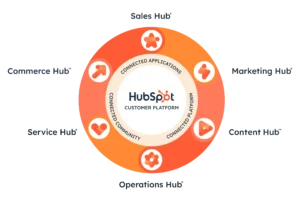HubSpot is a leading growth platform known for its customer relationship management (CRM) software and inbound marketing strategies. Founded in 2006 by Brian Halligan and Dharmesh Shah, HubSpot has grown into a versatile tool that helps businesses attract visitors, convert leads, and close customers. This article provides an in-depth look at HubSpot, its features, and its impact on businesses worldwide.
Introduction to HubSpot
HubSpot was born out of the idea that traditional marketing tactics were becoming less effective, and there was a need for a new approach to attract, engage, and delight customers. This led to the creation of inbound marketing, a strategy that focuses on creating valuable content and experiences tailored to the needs and interests of customers.
HubSpot’s platform is designed to support this inbound methodology, offering a range of tools to help businesses grow by transforming the way they attract, engage, and delight customers. HubSpot’s software suite includes tools for marketing, sales, customer service, content management, and more, all integrated into a single platform.
Key Features of HubSpot
- Customer Relationship Management (CRM)HubSpot’s CRM is at the heart of its platform, providing a centralized database for all customer interactions. It helps businesses manage and track customer relationships, providing insights into customer behavior, preferences, and needs. Key features of HubSpot CRM include:
- Contact Management: Store and organize contact information, including emails, phone calls, social media interactions, and website activity.
- Pipeline Management: Visualize and manage the sales pipeline, track deals, and forecast revenue.
- Task and Activity Tracking: Keep track of tasks, meetings, and calls to ensure timely follow-ups and efficient workflow management.
- Marketing HubHubSpot’s Marketing Hub is designed to help businesses attract and engage potential customers through various marketing channels. Key features include:
- Email Marketing: Create and send personalized email campaigns, track open rates, click-through rates, and conversions.
- Social Media Management: Schedule and publish social media posts, monitor engagement, and analyze performance.
- Content Creation: Create and manage blog posts, landing pages, and website content using HubSpot’s content management system (CMS).
- SEO Tools: Optimize website content for search engines, track keyword rankings, and analyze SEO performance.
- Marketing Automation: Automate repetitive marketing tasks, such as email workflows, lead nurturing, and segmentation.
- Sales HubHubSpot’s Sales Hub provides tools to help sales teams close deals more efficiently and effectively. Key features include:
- Email Tracking: Track email opens, clicks, and responses in real-time.
- Meeting Scheduling: Allow prospects to book meetings directly from your calendar, eliminating back-and-forth scheduling.
- Sales Automation: Automate follow-ups, task assignments, and lead rotation to streamline the sales process.
- Quotes and E-signatures: Generate professional quotes and collect electronic signatures to close deals faster.
- Sales Analytics: Gain insights into sales performance, track key metrics, and identify areas for improvement.
- Service HubHubSpot’s Service Hub is designed to help businesses provide exceptional customer service and support. Key features include:
- Help Desk: Manage customer inquiries, track tickets, and prioritize support requests.
- Knowledge Base: Create a self-service knowledge base with articles, FAQs, and guides to help customers find answers quickly.
- Customer Feedback: Collect and analyze customer feedback to improve products and services.
- Live Chat: Provide real-time support through live chat, allowing customers to get instant answers to their questions.
- Automation: Automate routine support tasks, such as ticket routing and follow-up emails, to improve efficiency.
- CMS HubHubSpot’s CMS Hub is a powerful content management system that allows businesses to create and manage their websites. Key features include:
- Drag-and-Drop Editor: Easily create and edit web pages without coding knowledge.
- Responsive Design: Ensure your website looks great on all devices with responsive design templates.
- SEO Recommendations: Receive on-page SEO recommendations to improve search engine rankings.
- Adaptive Testing: Test different versions of your web pages to see which performs best.
- Integration: Seamlessly integrate with other HubSpot tools and third-party apps.
The Impact of HubSpot on Businesses
HubSpot’s integrated platform has had a significant impact on businesses of all sizes and industries. By providing a comprehensive suite of tools for marketing, sales, and customer service, HubSpot helps businesses streamline their processes, improve efficiency, and drive growth. Here are some of the key benefits of using HubSpot:
- Improved Lead Generation and ConversionHubSpot’s inbound marketing tools help businesses attract more visitors to their websites and convert them into leads. By creating valuable content, optimizing for search engines, and using marketing automation, businesses can nurture leads and move them through the sales funnel more effectively.
- Enhanced Customer Relationship ManagementHubSpot’s CRM provides a centralized database for all customer interactions, allowing businesses to gain a 360-degree view of their customers. This helps sales and support teams deliver personalized experiences and build stronger relationships with customers.
- Increased Sales Efficiency HubSpot’s Sales Hub automates many routine sales tasks, allowing sales teams to focus on closing deals. Features like email tracking, meeting scheduling, and sales automation help streamline the sales process and improve productivity.
- Exceptional Customer Service HubSpot’s Service Hub provides tools to help businesses deliver exceptional customer support. By managing customer inquiries, creating a knowledge base, and collecting feedback, businesses can improve customer satisfaction and retention.
- Data-Driven Decision Making HubSpot’s analytics and reporting tools provide valuable insights into marketing, sales, and customer service performance. By tracking key metrics and identifying trends, businesses can make data-driven decisions and continuously improve their strategies.
Conclusion
HubSpot is a powerful growth platform that offers a comprehensive suite of tools to help businesses attract, engage, and delight customers. Its integrated approach to marketing, sales, and customer service allows businesses to streamline their processes, improve efficiency, and drive growth. Whether you’re a small business or a large enterprise, HubSpot provides the tools and insights you need to succeed in today’s competitive market.





